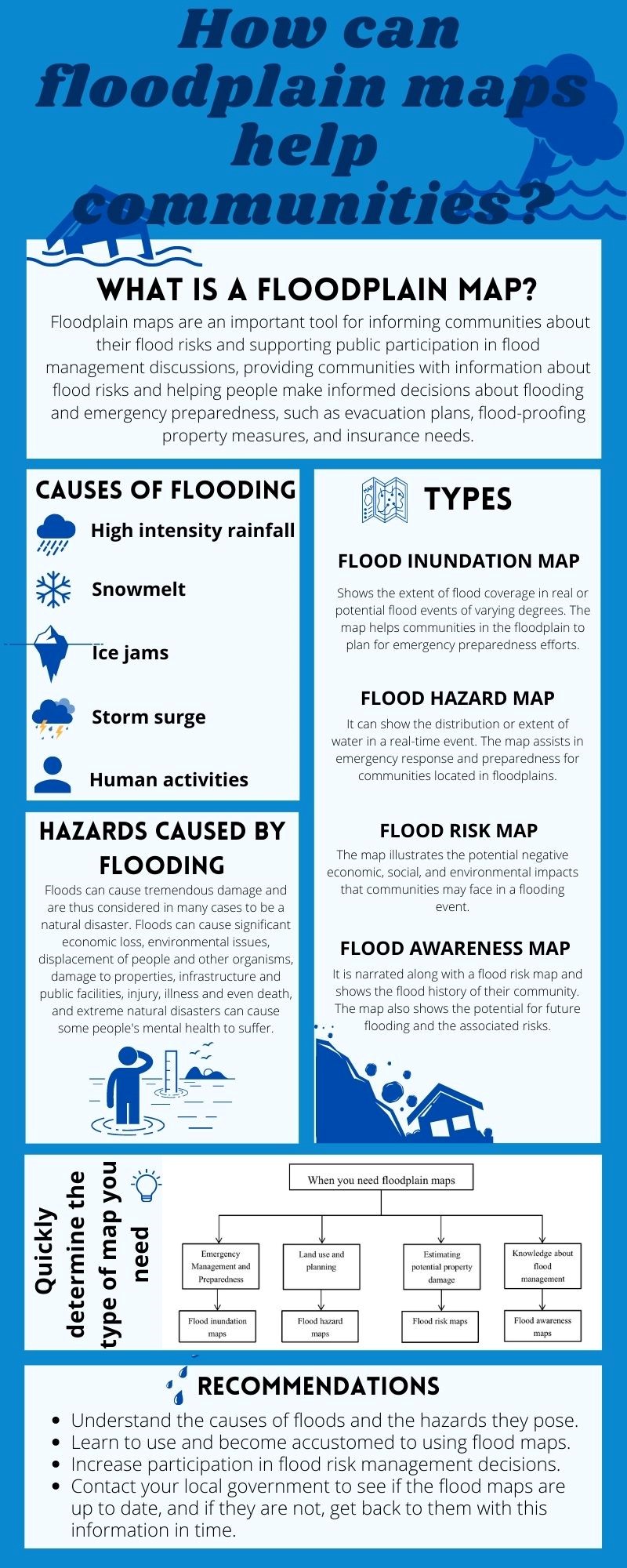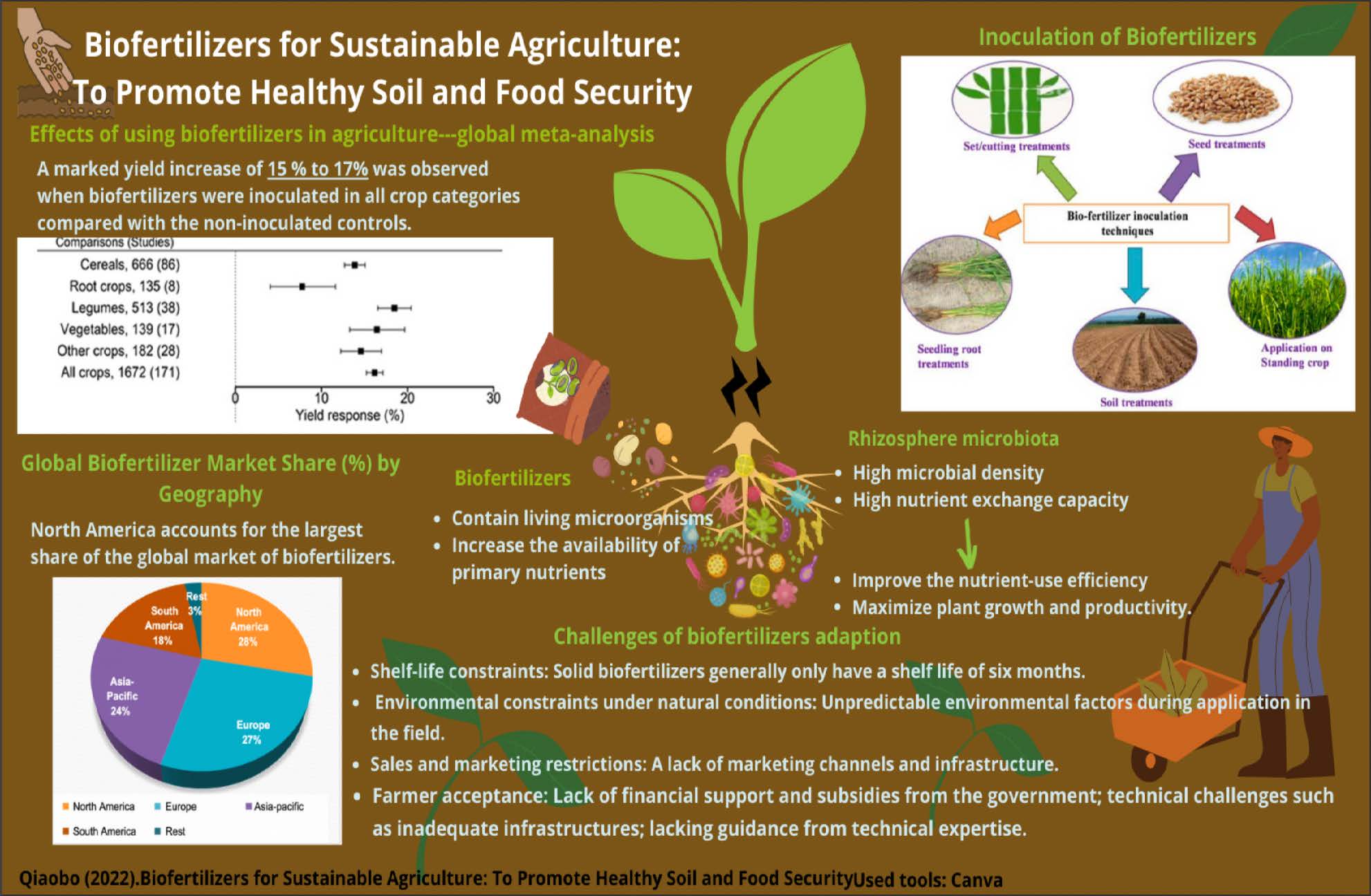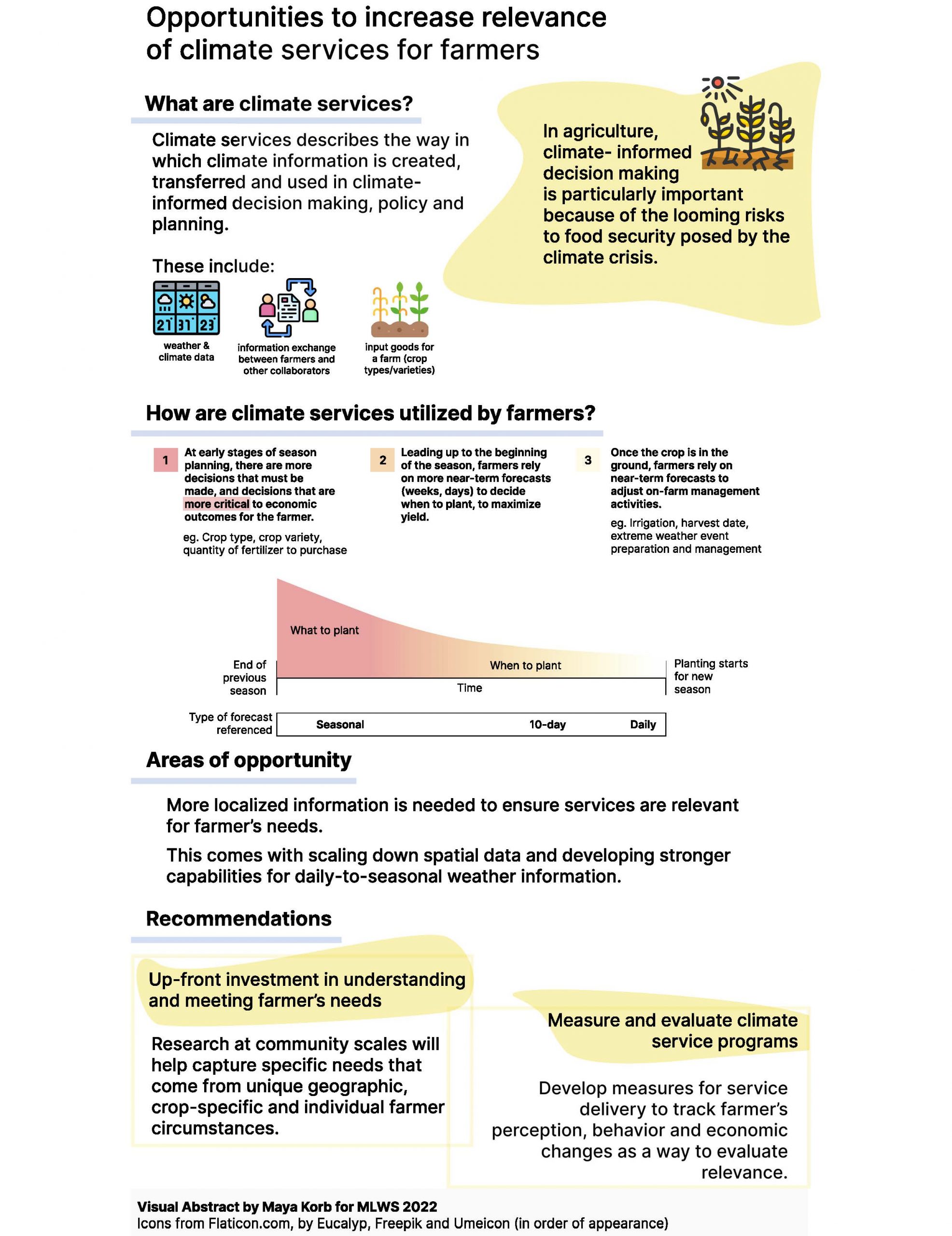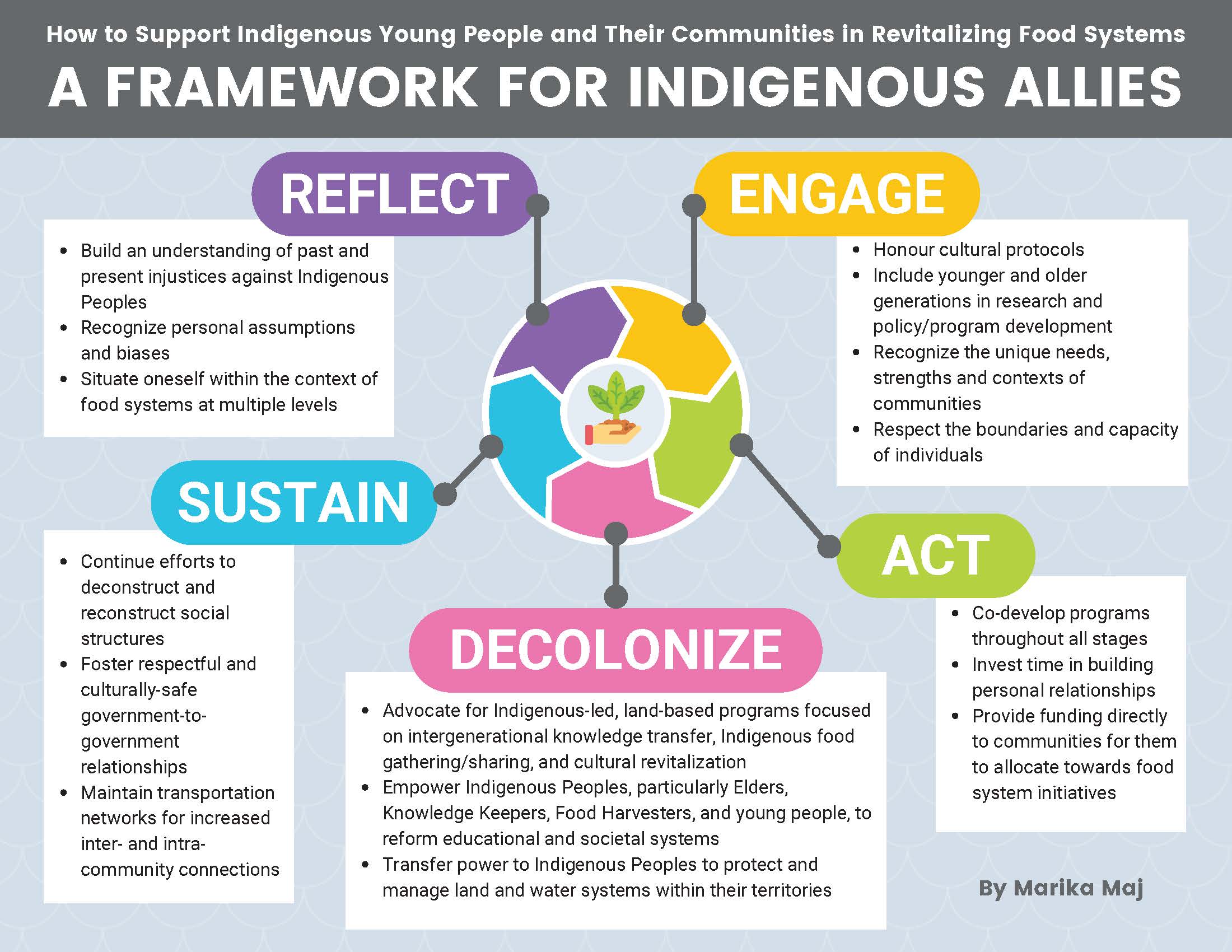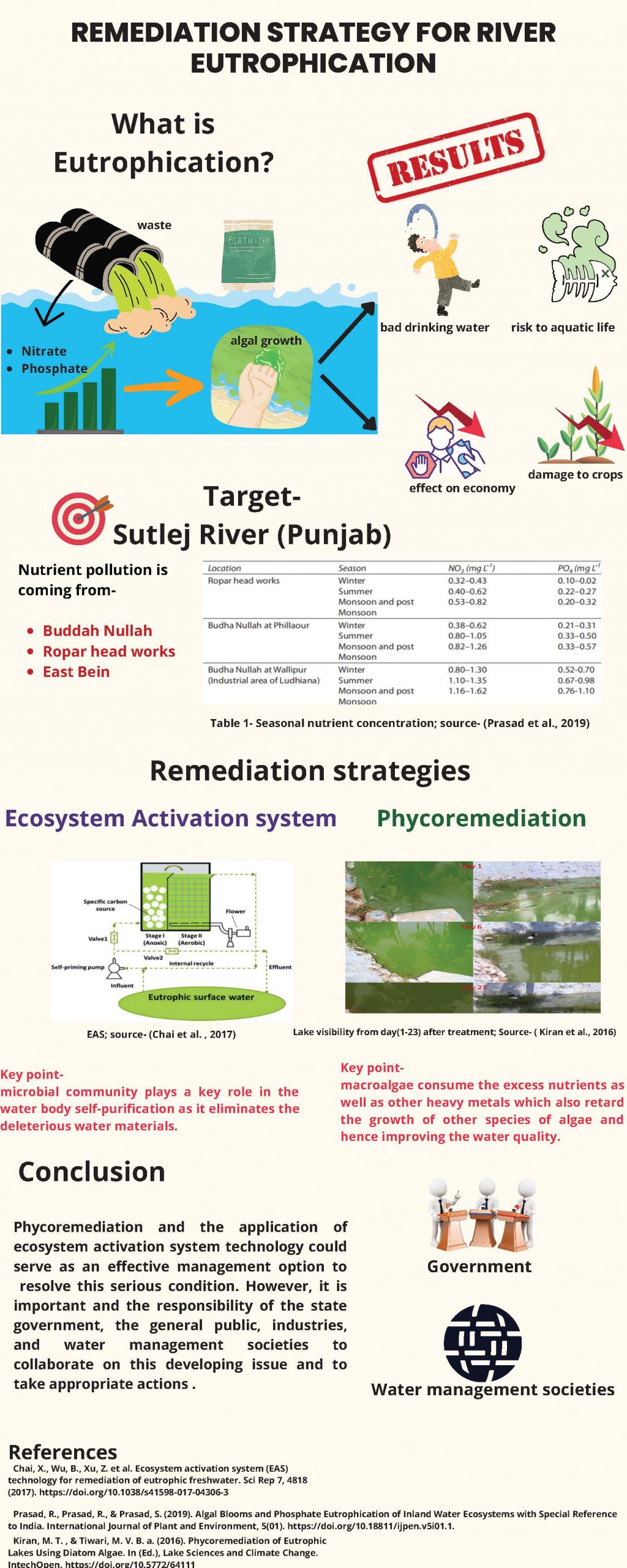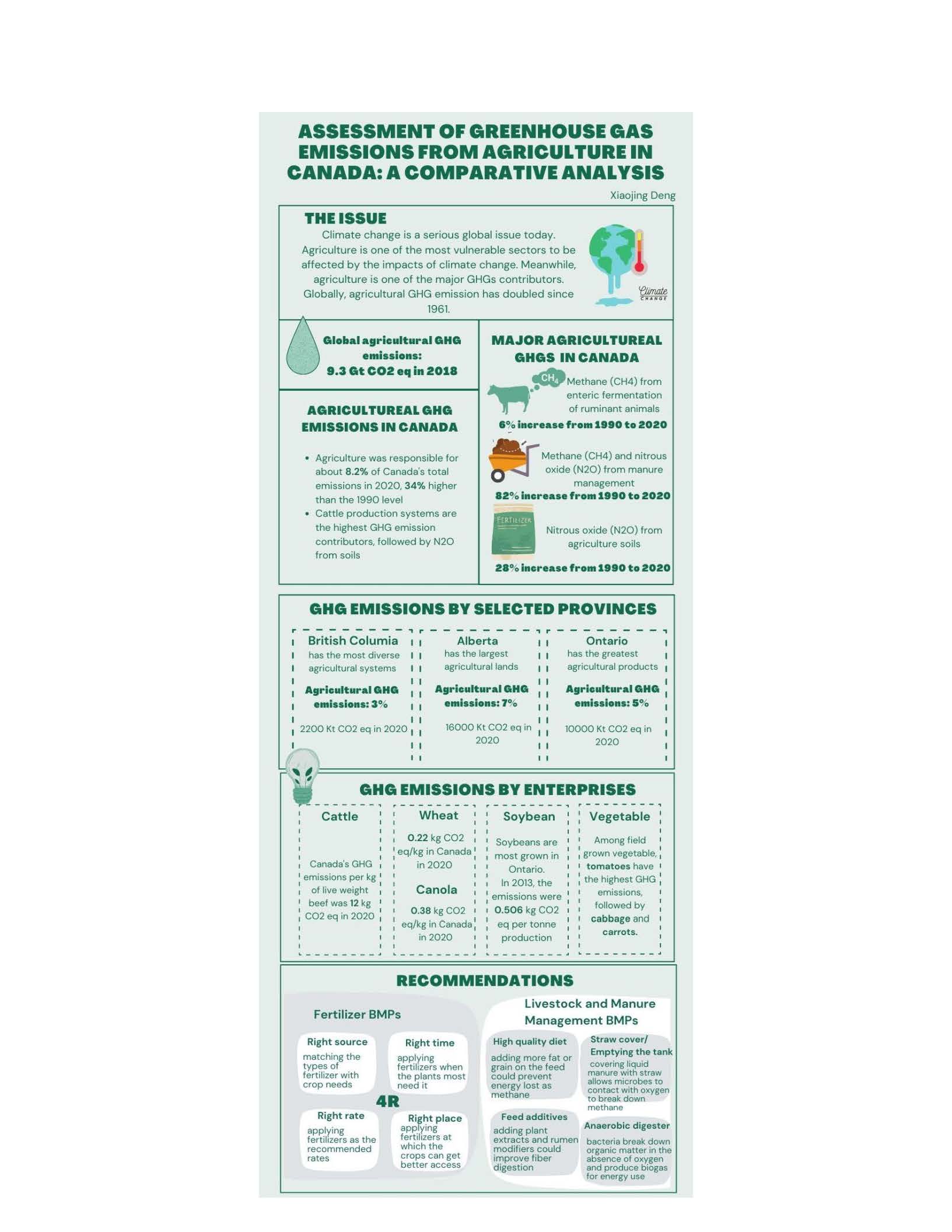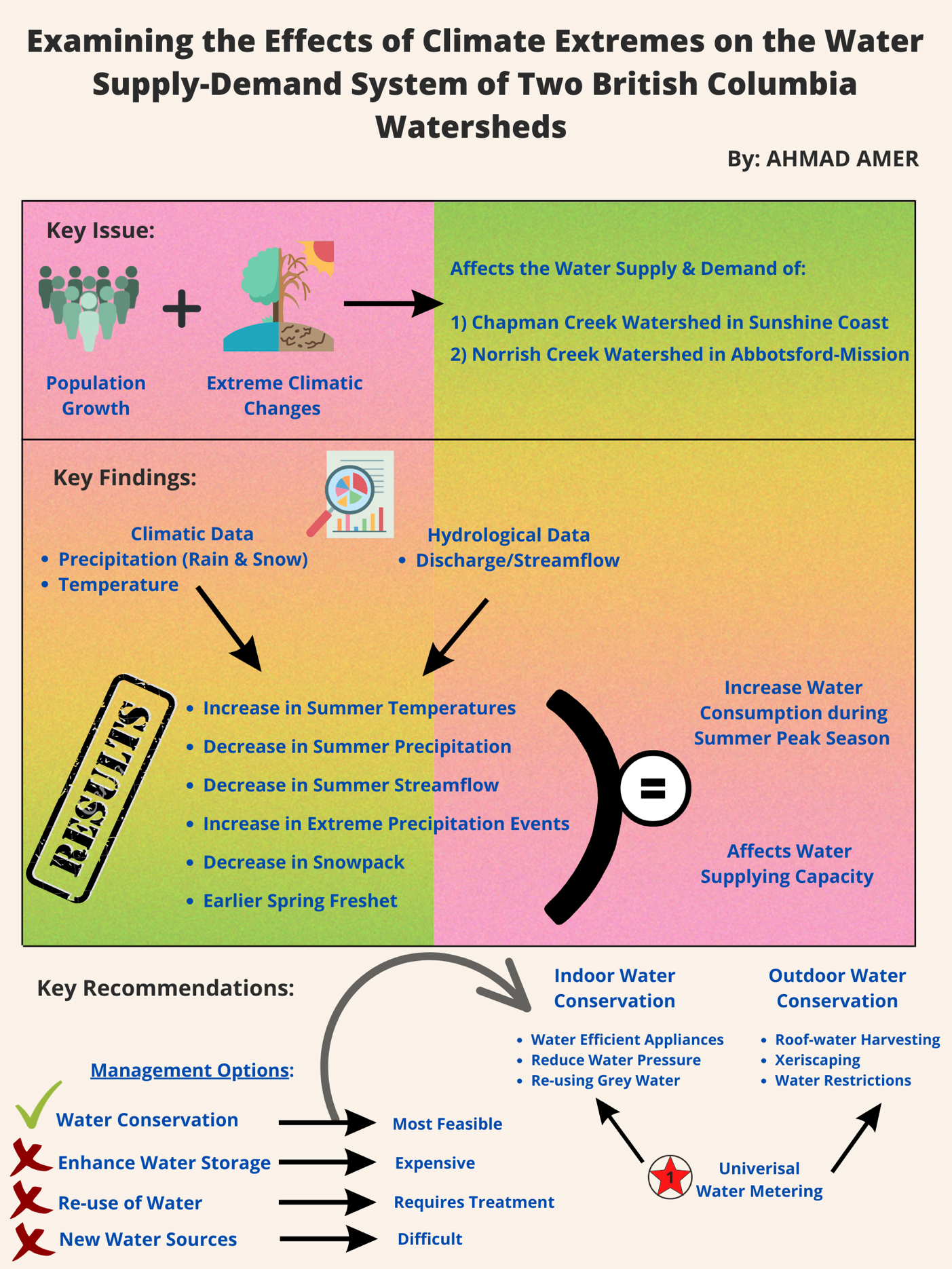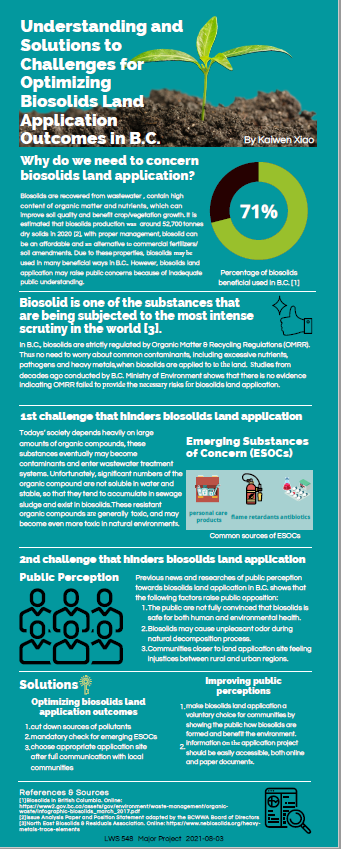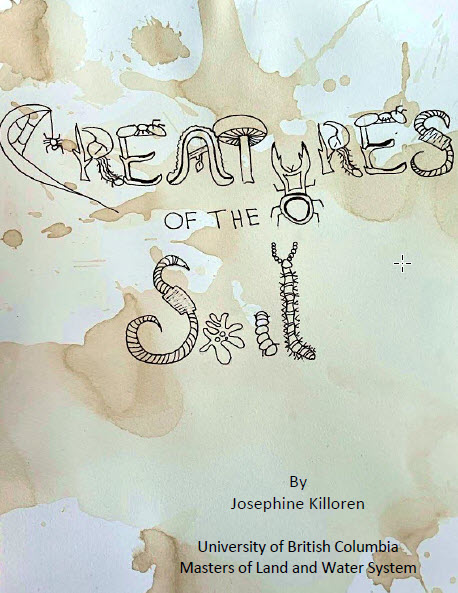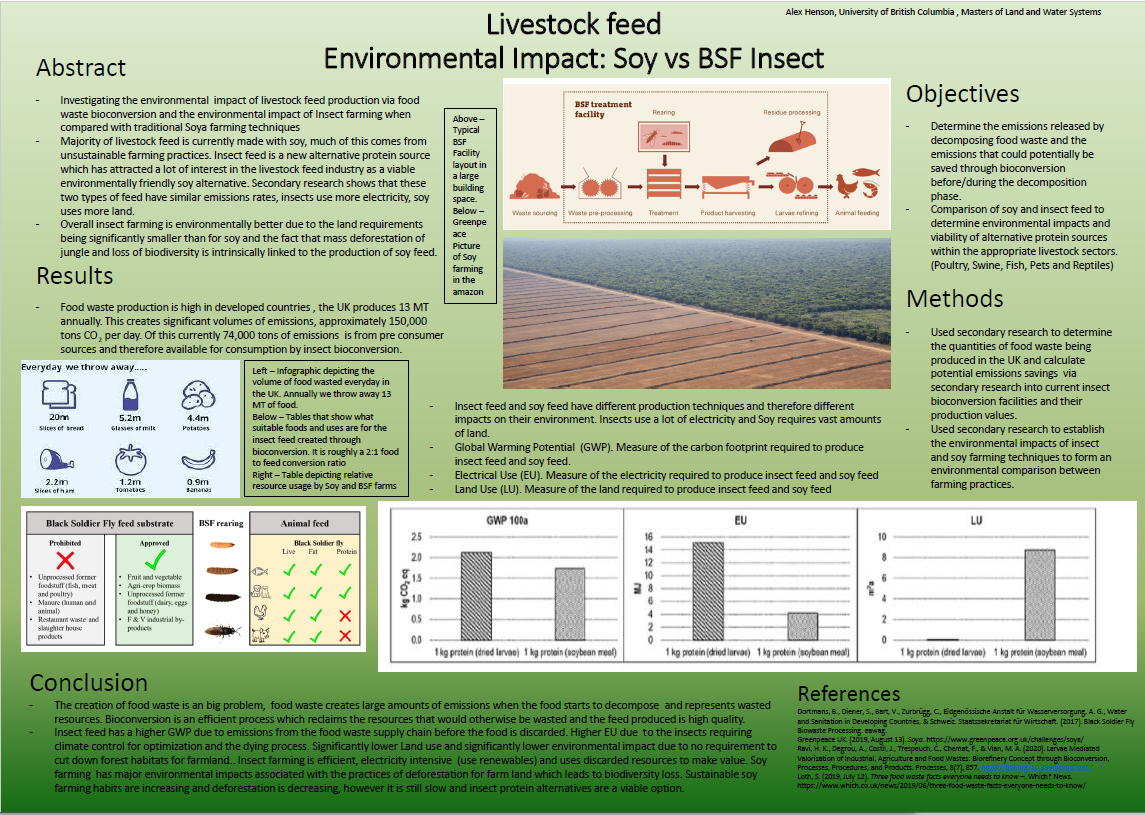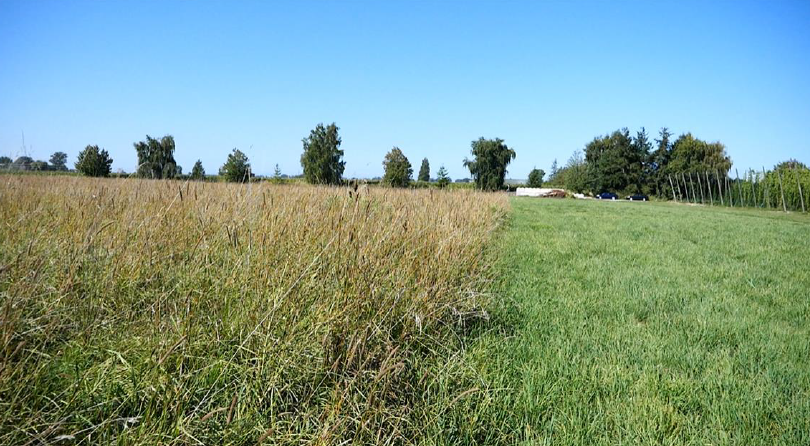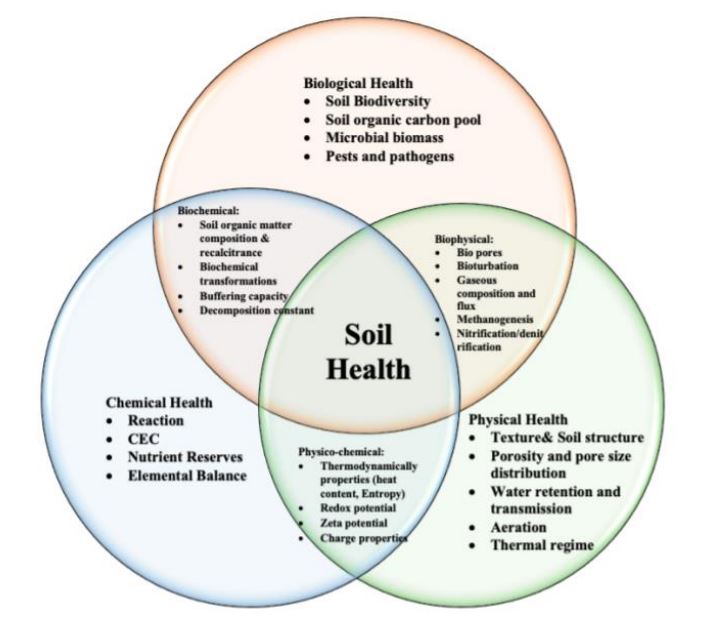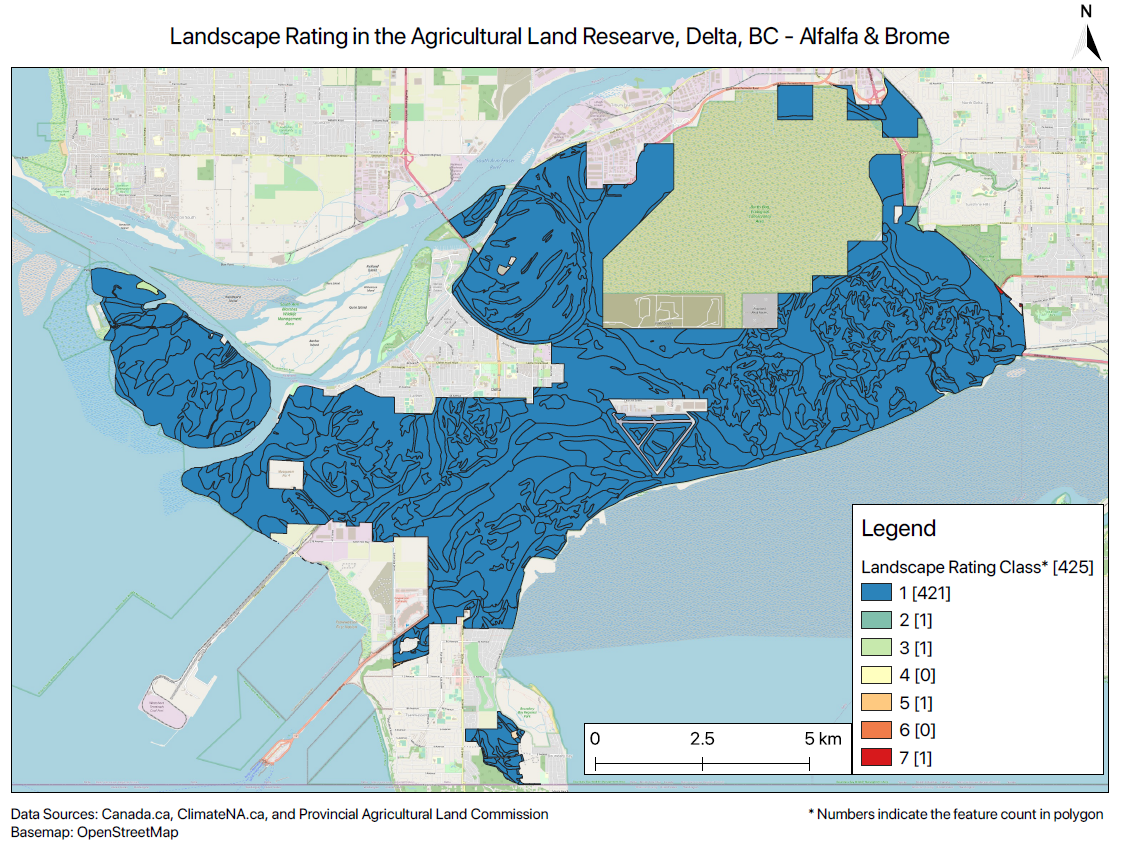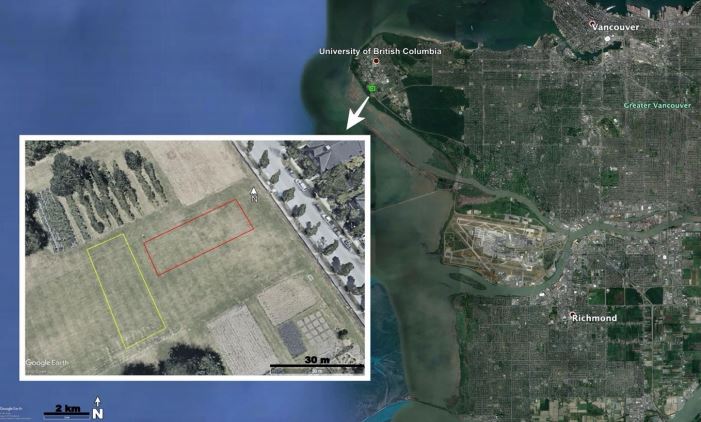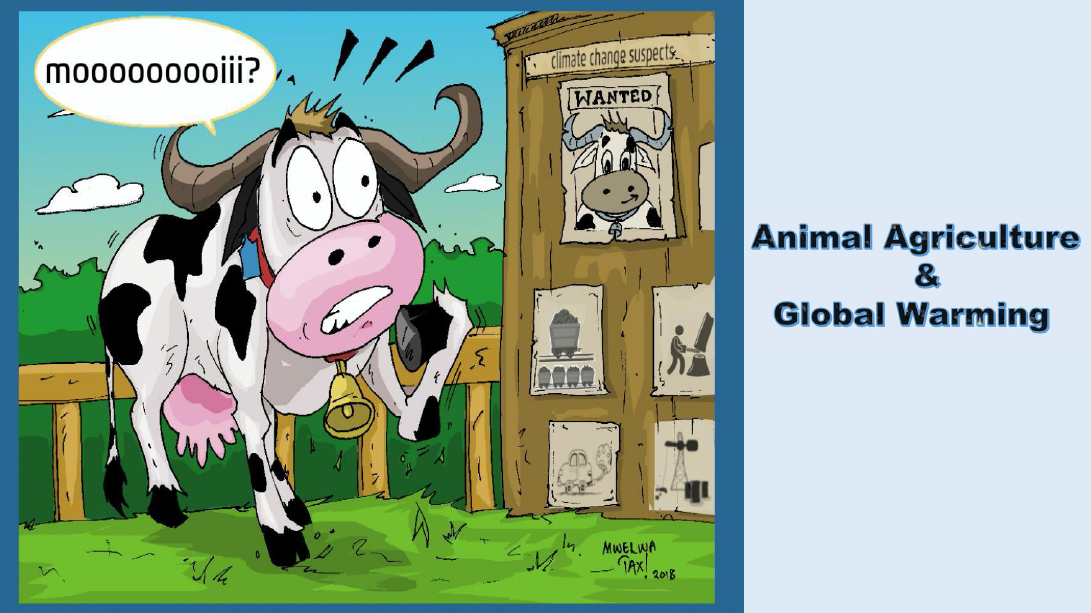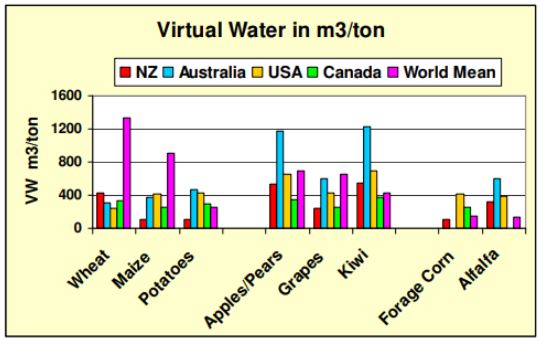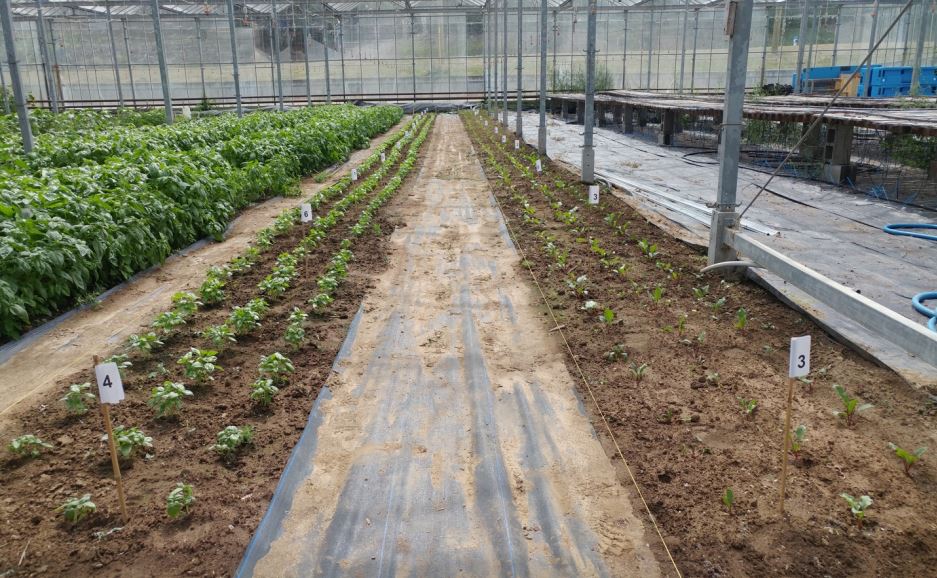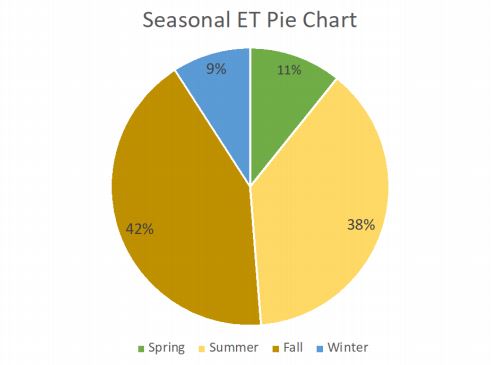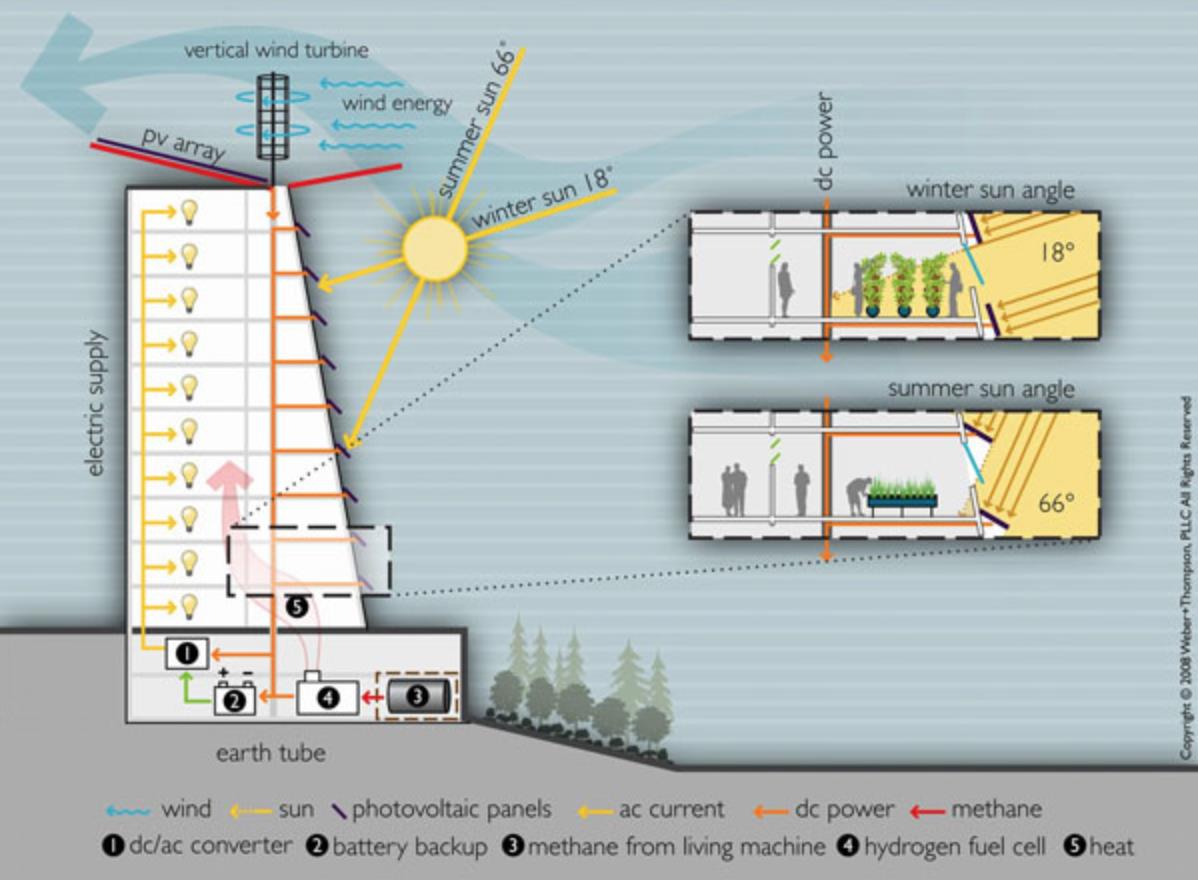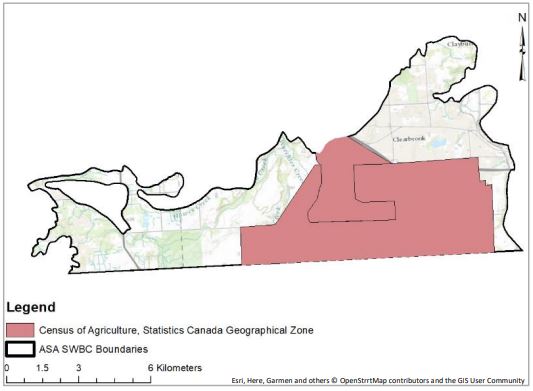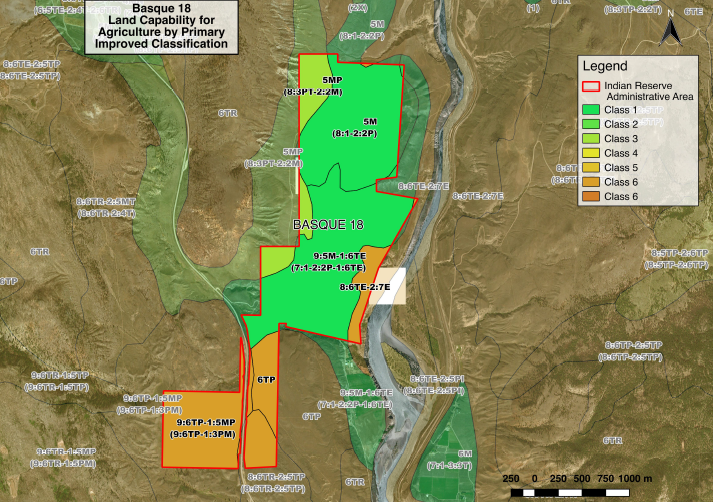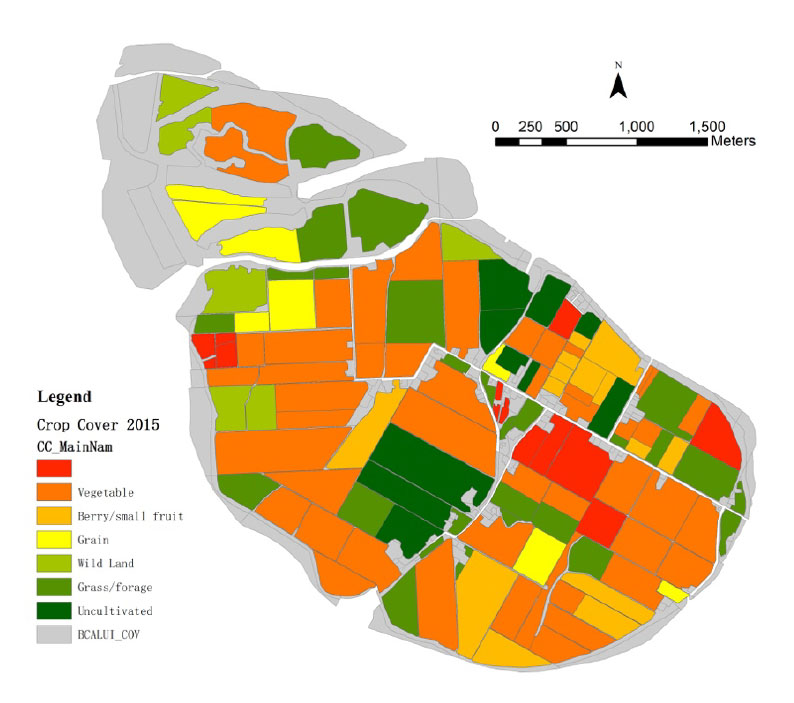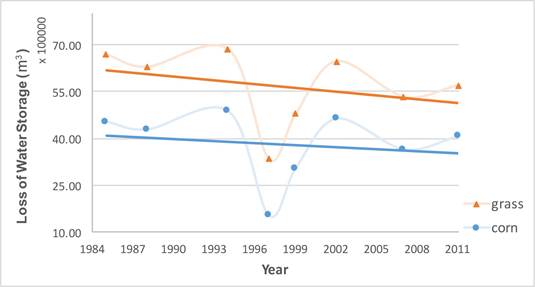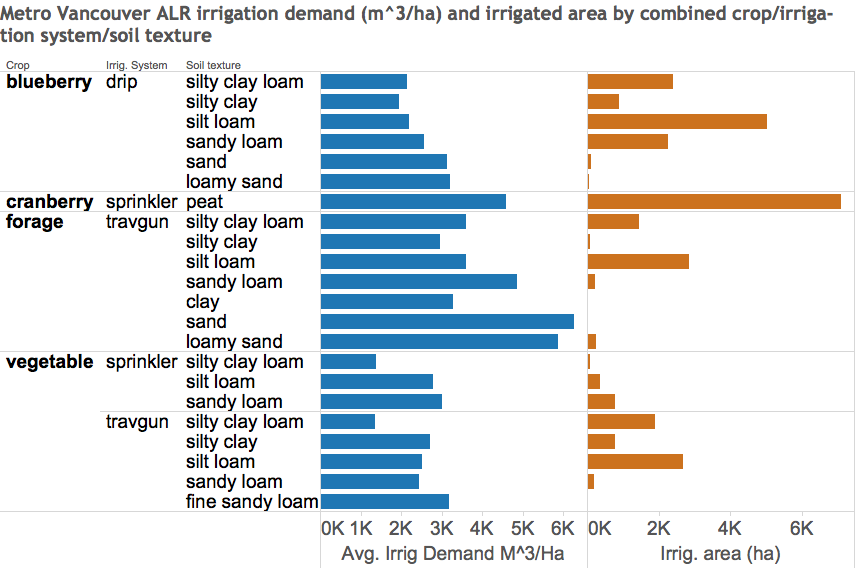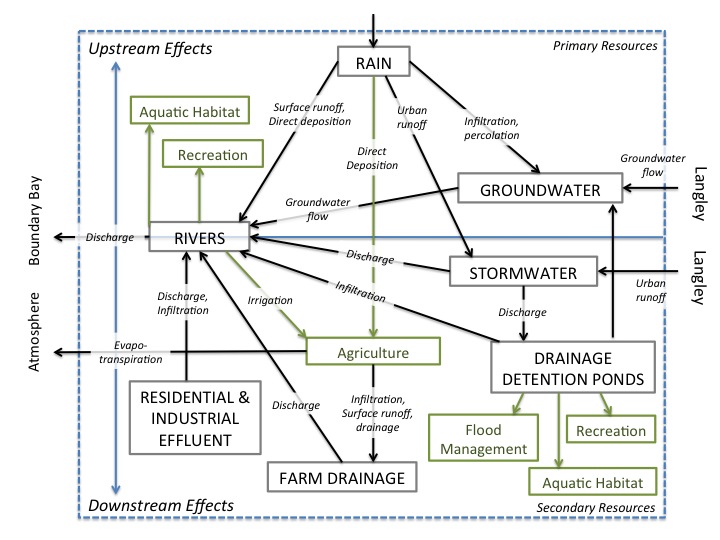Agricultural Land and Water
The following Major Projects investigate Agricultural Land and Water issues.
Aquaculture Development In Bhutan: Assessing Pre-Requisites And Addressing Environmental, Economic, Social Challenges And Opportunities
Ugyen Tshomo, MLWS 2024
Challenges to Green Infrastructure in Cities with High Water Tables: Appropriate Solutions and Suitable Locations in Richmond, BC
Lihao Wang, MLWS 2024
The Feasibility of Converting Sewage Sludges into Biosolids as a Fertilizer for Use on Agricultural Land in China
Shirley (Huiyuan) Liu, MLWS 2022
Rainwater Harvesting for Non-Potable Purposes
Chenling (Maisie) Lu, MLWS 2022
The role of floodplain mapping in managing flood risk in Canada
Yu Bai, MLWS 2022
Biofertilizers for Sustainable Agriculture: To Promote Healthy Soil and Food Security
Qiaobo Yang, MLWS 2022
Afforestation of Abandoned Agricultural and Degraded Land
Haoyue Wang, MLWS 2022
Opportunities to increase relevance of climate services for farmers
Maya Korb, MLWS 2022
FEED THE CULTURE, FEED THE PEOPLE:
Understanding the Role of Indigenous Young People in Revitalizing Food Systems
Marika Maj, MLWS 2022
Remediation of River Eutrophication
Harpreet Kaur, MLWS 2022
Biochar in Animal Agriculture: The Potential for Cascading Benefits and Resource Circularity
Jack Edgar, MLWS 2022
Assessment of Greenhouse Gas Emissions from Agriculture in Canada: A Comparative Analysis
Sylvia (Xiaojing) Deng, MLWS 2022
Examining the Effects of Climate Extremes on the Water Supply-Demand System of Two British Columbia Watersheds:
Ahmad Amer, MLWS 2022
Understanding and Solutions to Challenges for Optimizing Land Application of Biosolids Outcomes in BC
Kaiwen Xiao, MLWS 2021
Biosolids have been applied on land for more than a century. It has a high content of organic matter and nutrients and can improve soil quality effectively. In British Columbia, land application of biosolids has become a key solution to deal with land pressure and degradation, and the process is under strict regulations to preserve human and environmental health.
However, biosolids are recovered from wastewater, which means harmful pollutants may still exist in biosolids after standard treatment processes. Although the regulations introduced by the British Columbia Ministry of Environment have mentioned the level of common pollutants in wastewater and biosolids, the emerging organic pollutants researches since the 1970s and the public perception of biosolids have become two major factors hindering the widespread land application of biosolids.
This white paper presents a literature review, stating the properties of emerging organic pollutants and public perception of biosolids land application in British Columbia. In the end, it will provide solutions for the dilemmas to optimize the land application of biosolid outcomes.
Integrated Land Management of Low Capability Public Land in the Cariboo-Chilcotin
Emily Koopmans, MLWS 2021
What Is Soil Health? The First Step Towards Sustainability
Josephine Killoren, MLWS 2021
Environmental Impact of Food Waste Bioconversion by Black Soldier Fly Insects: Food Waste Consumption and Production of an Alternative Protein Source for Livestock
Alex Henson, MLWS 2021
This study investigates food waste bioconversion and ascertains whether it could provide a viable livestock protein source to mainstream alternatives such as soy, from both a production and an environmental perspective. The paper analyses bioconversion using insects as a method to refine food waste to produce protein in the United Kingdom examines the resultant reduction in terms of the environmental impact and draws a comparison with the production of soy.
The study suggests that insect feed produced by bioconversion is more environmentally friendly than soy-based animal feed. This is due to the extent of land required for the production of soy and the related deforestation coupled with biodiversity loss associated with farming this crop. However, insect feed requires more energy consumption than soy, potentially leading to an increase in global warming, although this can be mitigated by the use of renewable energy. Emissions savings relating to local insect production rather than soy importation is negligible as food is transported before being categorised as a waste product and then further transported to the insect farms and finally distributed as a product.
The study concludes that insect protein farming is both a viable replacement for soy farming and a more environmentally friendly alternative. However, insect protein farming as an industry is still in its early stages and it requires further innovation and research to determine the full potential of its application both as a food waste processor and as an alternative protein source.
Assessing Soil Organic Carbon on BC Farmlands as a Climate Change Mitigation Tool: An Overview
Georgia Stanley, MLWS 2021
In British Columbia, climate change is expected to impact life significantly, disrupting natural environments, economies, and the social fabric of communities (BC Ministry of Environment and Climate Change Strategy, 2019; Natural Resources Canada, 2014), and BC is not on track to meet targets for 2030 or 2050 (BC Auditor General, 2018). Drastic reductions in anthropogenic GHG emissions in the near-term will not be enough to prevent dangerous climate change (IPCC, 2018). A growing body of evidence suggests that agricultural soils could play an essential role in climate change mitigation through their capacity to serve as C sinks.
Assessment of Water Dynamics with Changing Land use in the Lower Fraser Valley, B.C.
Sophia Wang, MLWS 2020
Changing agricultural land use has impacted field water dynamics, as different crops and management practices have different water requirements. Thus, information is required to assess these changes in field water dynamics and develop strategies to manage water resources more efficiently, including assessment of alternative irrigation systems. Water stress in the Lower Fraser Valley (LFV): the conflict between growing agricultural water consumption demand and limited water resources. The LFV is one of the most densely populated and intensively farmed areas in BC. The unequal temporal distribution of rainfall makes irrigation demand even higher during the crop growing season. Agricultural development in the LFV relies on water resources, but climate change is likely to cause drier and warmer summers and wetter winters[4]. This tends to increase water stress due to the higher demand for irrigation.
Assessment of the State of Atmospheric Nitrogen and Phosphorus in the Lower Fraser Valley (LFV)
Ziqi Wang, MLWS 2020
Nitrogen (N) and Phosphorus (P) are critical nutrients in limiting the growth of plants and organisms. However, high-level atmospheric N and P can cause adverse effects on the receiving water, air, and soil ecosystems, triggering numerous environmental problems. This study focuses on the state of atmospheric nitrogen and phosphorus in the Lower Fraser Valley, British Columbia, Canada, and aims to find primary sources of emissions of nitrogen and phosphorus into the atmosphere. In the study area, there is a total of 25960 tonnes of N emitted into the atmosphere. Both agricultural and urban ecosystems contribute to N emissions. The agricultural emission is approximately 8260 tonnes of N, accounting for 71% of total NH3 emission and 10% of total NOx emission, mainly from fertilizer and manure volatilization and rural fuel combustion. In contrast, the emissions of NOx in the LFV is dominated by the urban ecosystem due to municipal solid waste incineration and fuel combustion. As for P emission, even though there is no robust data to quantify the emission sources, the finding suggests that dust emission and food waste incineration are the main drivers. With the increasing awareness of adverse effects associated with excessive atmospheric N and P, the government in British Columbia should pay more attention to this issue and develop relevant policies and management practices, and encourage more programs to focus on nutrients elimination mitigation.
Assessment of Regenerative Agriculture and Biostimulation as Forms of Alternative Agriculture:
Potential Benefits to Soil Health and Agricultural Production
Fayokemi OluwayemiI, MLWS 2020
Globally, several management practices in Agriculture, such as the application of pesticides/chemicals, inorganic fertilizers, and monocultural practices have contributed to land/soil degradation. This resulted in a loss of soil fertility and ultimately, poor quality of our food crops/plants. As the population of people increases daily, there is a critical need to improve crop productivity (yields) of nutritious, economical, and culturally appropriate food crops and promote healthier soils in our agroecosystem. Recent studies and discoveries have shown that the basis for agriculture, crop production, and human security in the future is healthy soil. Evidence has shown that “alternative” agricultural practices may provide solutions to curb issues surrounding soil and water degradation (FAO, 2015). These practices are adopted to promote healthier soils and can result in increasing crop productivity, greater economic viability, and increased local food security. Major emphasis is placed on ‘regenerative agriculture’ and ‘biostimulation’ as conservation and alternative approaches/management practices improve soil health and agricultural productivity. This paper presents a review and an assessment of regenerative agriculture and plant biostimulation and their potential benefits to soil health and agricultural production. It will summarize and communicate the benefits of these two innovative alternative practices to agriculturists, government officials, and farmers.
Land Suitability Assessment – Climate Ratings for Forage Crops in Delta, BC
Tong Ye, MLWS 2020
Intensive dairy production in the Lower Fraser Valley is dependent on a reliable source of forages, much of which is supplied from Delta. The land used for forages is economically important within the Agricultural Land Reserve in British Columbia. The project addressed climate change adaptation of Delta’s agricultural sector forage crops by assessing the climate ratings of land suitability, based on the Land Suitability Rating System for the lands within the Agricultural Land Reserve in Delta, B.C. It thereby predicted the effects of future climate change scenarios.
Overall, the climate rating class improved for both legume and grass forages under the climate change scenarios. The limiting factor of climate shifts from heat requirement to moisture requirement through the years. Soil ratings can limit the final land suitability rating under hot dry climate change scenarios. Land suitability assessment and mapping for multiple crops are suggested for future studies for agricultural land use planning purposes.
Understanding and Evaluating Methods for Assessing Soil Compaction in Agri-Food Systems
Amy Sigsworth, MLWS 2020
Soil plays a significant role within the hydrological cycle by providing a medium for infiltrating water to be stored in the rooting depth and a conduit for groundwater recharge. Effective infiltration and percolation are imperative in agricultural systems to reduce water erosion and maintain soil quality, enhance water use efficiency by storing water in the rooting zone, foster groundwater recharge which may further service domestic and agricultural water users in the region, and to reduce the effects of heavy rainfall events such as flooding. Infiltration is directly influenced by soil compaction which is a concern in agri-food systems. In order to maintain hydrological functions at the farm scale, as well enhance productivity, land managers commonly assess soil compaction in production fields. However, current tools, such as the Soil Compaction Tester (SCT), are not efficient in assessing spatial variability at the farm scale. This project evaluated ground-penetrating radar (GPR) as a method of assessing soil compaction in both cultivated and non-cultivated fields. The GPR results were compared to results from the SCT and soil analysis from core samples. The results demonstrated the potential for GPR as an efficient technique in assessing compaction at the field scale in certain circumstances and soil textures. Further research is recommended in larger scale and more established production systems to test the method’s efficiency in assessing soil compaction and spatial variability.
Water Demand for Vertical Farming – Advantages and Challenges
Danyang Han, MLWS 2020
The concept of vertical farming has been introduced to improve food safety and production, as well as using less water, land, and other natural resources. This project aims to explore the differences between water demand per unit of production of vertical farming and traditional farming, especially for lettuce. Besides, the various sources of water supply for vertical farming will be listed to see the costs for irrigation in these ways. The approach for the study is based on the BC water calculator and data analysis of local vertical farming lettuce production. Based on conclusions from the research above, advantages, limitations, and challenges of vertical farming can be shown through comparisons with traditional farming.
Assessment of GHGs from Animal Agriculture with a Focus on Manure Application and Dairy Operations
Caroline Ding, MLWS 2020
It is widely acknowledged that greenhouse gas is the major contributor to global warming. The linkage between the burning of fossil fuels and global warming might be the first to come to mind when talking about global warming. Globally, carbon dioxide emission from the burning of fossil fuels is indeed the top source of greenhouse gas emissions, other types of greenhouse gas emissions are also noteworthy because gases, such as methane and nitrous oxide, have much greater warming potential than carbon dioxide.
This study is primarily a summary of the globe’s, Canada’s and British Columbia’s greenhouse gas emissions with a focus on animal agriculture. To have a better understanding of the greenhouse gas emissions from animal agriculture, a case study of a dairy farm was conducted, focusing on manure management of the farm.
Wasted Food in Canada and Its Impact on Water Resources
– Small Fruits in Creston, BC: A Case Study
Sodiya Oluwaseun, MLWS 2019
Globally, there is a growing consensus that we need to act to address food loss and waste. Food waste refers to food intended for consumption that is discarded without being eaten or reaching the market. In Canada, this amount is closer to 40% according to Value Chain Management International (2014). Food loss and waste have many negative economic and environmental impacts. Environmentally, food waste inflicts a host of impacts, including emission of greenhouse gases and inefficient use of water and land, which in turn can lead to diminished natural ecosystems services.
In B.C, approximately 2.3 million tonnes of food waste was disposed of in 2016 (VCM Inc) and Creston Valley being one of the prime agricultural production regions in B.C contributes to this figure. It is suggested that the Creston Valley will continue to be the hub of agriculture in the region of B.C. Fruits and vegetables are one of the largest sources of waste by weight. Much of the wasted weight in fruits and vegetables is water.
Sustainable Agriculture – The Contribution of Biostimulation
Likhita Kiran Miriyapalli, MLWS 2019
To meet the growing demand for food production, due to the rapidly increasing population, there is a need for sustainable agricultural systems that are economically viable, environmentally safe and socially fair. Social concerns of conventional farming combined with the growing demand for sustainable agriculture and food safety have led to the emergence of alternative agricultural systems. Those emerging innovations and agricultural practices play a crucial role in ensuring sustainable food production systems. One of such innovations is plant biostimulation, which may make existing practices more efficient and sustainable. “Plant biostimulants contain substance(s) and micro-organisms whose function, when applied to plants or the rhizosphere, is to stimulate natural processes to enhance/benefit nutrient uptake, nutrient efficiency, tolerance to abiotic stress, and crop quality.” This paper presents an overview of plant biostimulation, its contribution to sustainable agriculture. Benefits and challenges of biostimulation are outlined, including uses, application in agricultural systems, public perception, global and market analysis.
Assessment of Heavy Metals in the Arbutus Greenway, Vancouver
Bixin Lin, MLWS 2019
From 1902 to 2001, Vancouver’s Arbutus Greenway served as a railway for regional freight and interurban passenger transport service. In March 2016, the City of Vancouver purchased the Arbutus Corridor from the Canadian Pacific Railway (CPR) built this corridor into a greenway.
The overall aim of this study was to provide an evaluation of potential heavy metal contamination along a recently de-commissioned railroad track in Vancouver and a particular section that has a history of small scale raised bed community gardens. This study focuses on Vancouver transportation corridor, the Arbutus Greenway, as a case study. Five random sites were selected in Zone 1 of the Arbutus Greenway. The pH, ash content and heavy metal concentration of the soil were determined. The metals Cd, Co, Cr, Cu, Ni, Pb and Zn were selected as important in relation to human exposure.
Groundwater Predictive Model on the Effect of Land Use Impacts on the Hopington Aquifer in Langley, BC
Juncheng Hu, MLWS 2019
The Hopington AB Aquifer is one of the most vulnerable unconfined aquifers in the lower mainland. It is reported that the Hopington AB aquifer water level is decreasing year by year. The predictive model indicates that these declines are due to excessive extraction, climate change and expected population growth will only accelerate the drop in water tables. In order to address the groundwater quantity issue, a groundwater management plan is needed to regulate and protect the unconfined aquifer.
The overall goal of the project is to determine the water balance of the Hopington Aquifer and its possible impact on streamflow in the Salmon River. The aim is to develop a predictive model to determine the effect of land use activities and water use on the Hopington Aquifer, to show if the aquifer is used in a sustainable manner and to evaluate if changes affect the stream water flow in the Salmon River.
GIS Assessment of Groundwater Recharge Potential in Whatcom County, Washington State:
Implications for Land Use
Olatunbosun Ayetan, MLWS 2019
Ecosystem services such as groundwater recharge play an important role in sustainable management of groundwater resources. The present study was carried out to identify and map zones in the North Lynden Watershed Improvement District (NLWID) that have productive groundwater recharge potential using Geographical Information System (GIS). The NLWID is part of the Fishtrap Creek Watershed, which is faced with land use changes, loss of resource land and farmlands that have the potential to reduce natural recharge of the Sumas-Abbotsford Aquifer. A penetrometer field test was carried out to investigate soil compaction and the relationship between land cover and groundwater recharge potential. The penetrometer field test qualitatively revealed that land cover and the required management practices in addition to the soil types can affect groundwater recharge potential. The results of the study can be used to formulate an efficient groundwater recharge management plan for sustainable utilization of limited groundwater resources.
A Synthesis of Restoration Practices for Degraded Croplands in Dryland Regions
Asif Saleem, MLWS 2019
Restoration of degraded croplands are needed to ensure the sustainability of rain fed agriculture, and, thus food security, to meet the growing demands for food, fibre and shelter. Unsustainable agricultural techniques, land and water use, and climate change impacts are the main drivers for the degradation of drylands, which has resulted in the decline of ecosystem services, food insecurity, social and political instability. It has reduced ecosystem resilience to climate variability. The typical rehabilitation measures for restoration of degraded agricultural land are achieved through using agronomic and biological techniques, such as crop rotation, agroforestry, cover crops, vegetative filter strips, residue, and zero or reduced tillage.
This study evaluates and provides recommendations for significant gains and successes that have been made by governments, local communities, non-governmental organizations, the scientific and research community, as well as other stakeholders. This project identifies the challenges in the restoration of drylands and suggests recommendations for dryland restoration.
Vertical Farming Feasibility: The Opportunities and Challenges of Adapting Vertical Agriculture
Jie Sheng, MLWS 2018
As the human population continues to increase and land becomes more valuable, a day will come when people cannot completely rely on the produce from conventional farms. This study focuses on the technologies and challenges of adapting vertical farming as a new solution to feed the world’s population and potentially change our food system. The goal of this study is to analyze the theory and the potential of vertical farming in addressing the issues that exist in today’s food system. This study also conducts a comparison between the greenhouse system and vertical farming to determine the differences and the potential benefits behind vertical farming. Finally, to evaluate the feasibility of vertical farming, this study gives an opinion about the challenges to be overcome in this field and defines if vertical farming is a viable option to supply food to cities in an energy efficient and sustainable way.
Comparative Transboundary Nitrogen Budget of the Abbotsford–Sumas Aquifer
Kamal Kakish, MLWS 2018
Transboundary groundwater issues are of significant importance. The depletion of aquifers is adding pressure to growing water scarcity in many parts of the world; and groundwater quality is being reduced as a consequence of several sources of anthropogenic pollution, which eventually restricts its uses in certain applications.
Future sustainable management of shared resources requires a shift toward holistic cooperation, while strengthening the scientific knowledge available, to effectively inform policy actions. This is particularly important within the Abbotsford – Sumas Aquifer, a Transboundary Aquifer (TBA) system shared by British Columbia and Washington State, USA.
In this paper, a comparative nitrogen budget analysis is conducted on the Abbotsford-Sumas Aquifer and includes all major agricultural nitrogen flows. The study compares nitrogen surplus amounts on both sides of the border. This provides an indicator of excess nitrogen that could be leaked into the environment and eventually contribute to the contamination of the aquifer. Furthermore, conceptualizing nitrogen flows at the regional scale within the extent of the aquifer could promote a more effectual design of intervention measures and conjunctive policy creation for the sustainable management of the transboundary Abbotsford-Sumas Aquifer.
Phosphorus Dynamics for Efficient Nutrient Management in Organic Agriculture
Cagla Buzluk, MLWS 2018
There exists a wide range of observable inefficiencies in phosphorus (P) management in current organic agriculture. This paper’s objective is to increase the understanding of P dynamics in order to increase the P efficiency in organic agriculture. As a result of the nutrient imbalances in organically accepted nutrient sources and the high reactiveness of P, the management of P is challenging. One of the major contributors to the P inefficiencies in organic agriculture is the strong focus on meeting plant nitrogen (N) needs. Considering the growing global trend towards organic agriculture, decreasing P inefficiencies is important for both increasing the future sustainability of farms for the efficient use of P sources and decreasing the environmental impacts of organic farms on concerns such as eutrophication.
Food Security Concerns and Challenges of First Nations Communities in the Interior of BC
Brittany Myhal, MLWS 2018
The vulnerability of rural communities is a global issue that has been persisting for decades. As development pressures increase and climate change intensifies, these communities are forced to shift their reliance on local resources to imported goods. Due to the low population density of rural areas relative to urban centres, they hold less political power and their needs are often not prioritized by government. As a result, even communities in a resource abundant province such as British Columbia are experiencing food and water security issues. Rural First Nation communities have been particularly vulnerable as they have a history of being marginalized which has impacted their livelihood and decreased their ability to remain resilient to change.
This is a preliminary report intended to explore the main challenges and concerns regarding food security in rural communities in BC from a First Nations perspective. Two communities in BC’s interior were selected and visited. The first was Lytton First Nations and the second organization was Esh-Kn-Am Cultural Resources Management Services, which represents three different First Nations bands. There was greater focus placed on Esh-Kn-Am as they expressed more concern than the Lytton community in regard to their local food security.
Cooks Ferry Indian Band: Land Capability Assessment
Luc Anderson, MLWS 2017
Cooks Ferry Indian Band at Spences Bridge, like many rural communities, is experiencing major challenges in maintaining a viable socio-economic future due to urbanization and population dynamics. Dependence on a limited range of economic bases such as agriculture, mining, forestry, fishing and recreation ties opportunities for employment to the success of these industries. The migration of skilled people and notably younger generations, to urban centers has resulted in a decline of human resources. There has been little attention given to developing a community-based resources inventory to guide communities as they seek to incorporate emergent and innovative opportunities. The utilization of a computer-based land capability classification framework is a first step in providing an ecological base for resources planning and development.
Integration of Agriculture and Wildlife Ecosystem Services:
A Case Study of Westham Island, British Columbia, Canada
Yuan (Ellen) Zhang, MLWS 2016
There is concern regarding the loss of ecosystem goods and services as a result of land use changes, such as the expansion and intensification of agricultural activities. Assessments of these interactions require innovative analyses that combine qualitative and quantitative economic analyses. The Millennium Ecosystem Assessment framework was applied to a peri-urban region in British Columbia to assess the effects of the integration of agricultural programs and the maintenance of waterfowl habitat located on the Pacific Flyway.
The Delta Farmland & Wildlife Trust, a non-governmental organization, has implemented several activities to enhance eco-system goods and services by cooperative programs among the agricultural community and wildlife interests. The successful collaborative framework has resulted in enhanced soil quality, increased biodiversity, and the maintenance of valuable agriculture and waterfowl habitat.
Assessment of the opportunities and challenges of organic cranberry production in BC
Adarshana Thapa, MLWS 2016
Cranberries are known to have beneficial health effects but there is a limited supply to meet local markets. As the demand for organic foods expands, interest in exploring organic cranberry production in British Columbia rises. Commercial cranberry production in British Columbia is well documented, but there is little information about the feasibility of growing organic cranberries.
This study focused on the economic feasibility and challenges of growing organic cranberries in the Lower Fraser Valley of British Columbia, the major producing region for cranberries in the province. The feasibility evaluation was based on three scenarios: a) growing cranberries on a field that has not been cultivated before; b) transitioning a field from conventional to organic cranberries; c) transitioning from an organic crop to organic cranberries. This study integrated information from industry experts, local organic cranberry growers, researchers and academics. A financial analysis was conducted to provide an assessment of the economic feasibility of initiating organic cranberry production. A financial model, based on a 15-year time frame, was developed to be used by growers. The model projected that an economic break-even time of 7-14 years could be achieved.
Analysis of Impervious Surface Area, and the Impacts on Soil-Based Agriculture and the Hydrological Cycle:
A Case Study in the Agricultural Land Reserve in Metro Vancouver, BC, Canada
Ashley Rose, MLWS 2016
The Agricultural Land Reserve (ALR) was originally established with the goal of protecting prime agricultural soils from being lost to urbanization and other development in the province of British Columbia. However, there are a wide array of activities that are permitted in the ALR such as the construction of greenhouses, crop and dairy barns, estate-sized homes, roads, and commercial facilities that permanently seal the soil with impervious surfaces and take the soil out of production.
The objective of this study was to estimate the extent of impervious surface area in the Metro Vancouver ALR in order to analyze the impacts on the hydrologic cycle and to quantify the amount of arable agricultural land that is taken out of production, based on the Soil Capability for Agriculture classification. The information in this report is useful in developing watershed protection strategies and assisting policy makers in making land use decisions to protect the long term integrity of the ALR and soil-based agriculture.
Effects of Aggregate Extraction on Water Storage in the Pepin Creek Watershed, British Columbia, Canada
Yining (Rachel) Wang, MLWS 2016
View article in Scientific Researcher – An Academic Publisher
Rain Water Harvesting with the Homegrown Rainwater Model
Encouraging Alternative Water Resources for Small Scale and Urban Agriculture
Acadia Tucker, MLWS 2015
Alternative water resources, like rainwater harvesting, are under-utilized yet offer a decentralized approach that can increase the reliability and resiliency of urban water supplies, particularly for urban agricultural production. By exploring alternative approaches to water use and distribution, urban areas can decrease their dependency on large scale water systems and avoid the risks associated with centralized water supplies. Now is the time to start planning for a more unpredictable future in a way that mitigates the adversity linked with these events. The Homegrown Rainwater Model was designed and developed to help small scale growers determine the feasibility of installing a rainwater system at a site. The model design is based on three different steps to help users fully understand the potential system requirements that work best for each individual situation. The model predicts a specific location’s water supply and demand based on easily accessible information such as local precipitation, air temperature and irrigated area.
Understanding Irrigation Demand in Metro Vancouver
An Application of the Agricultural Water Demand Model
Naomi Robert, MLWS 2015
Managing water quantity and quality in the Metro Vancouver region is an ongoing challenge under seasonal periods of water stress, particularly in the agricultural sector, a primary water consumer. Poor or absent regulation and monitoring of groundwater and surface water use in agriculture severely limits the capacity to assess water reserves and consumption and strategically manage water resources. This creates uncertainty regarding future water availability and risk within the agricultural sector. Improving our understanding of irrigation demand for agricultural production is a crucial step toward strategically managing the water resources upon which the agricultural industry depends.
This investigation aims to address this concern by using the Agricultural Water Demand Model, as developed by the BC Ministry of Agriculture, for Metro Vancouver (AWDM) as a comparative assessment tool. The AWDM is used to investigate irrigation demand within Metro Vancouver’s Agricultural Land Reserve in order to inform policy makers with regards to water management.
Connecting the Drops:
An Agricultural Water Assessment and Strategy for Surrey, BC
Michelle Radley, MLWS 2015
Conflict over resources is particularly problematic in peri-urban areas where urban and rural development relies on the same land and water resource systems. Peri-urban agriculture is a valuable form of agriculture that provides environmental, recreational, and food security benefits to urban areas. However, urban competition for land and water and a lack of system-based planning has led to the fragmentation of arable land, stressed water systems, and a consequent decline in the potential for peri-urban agricultural production.
This project uses the city of Surrey, British Columbia, Canada as a case study for developing a regional, system-based strategy for increasing peri-urban agricultural productivity. The strategy focuses on integrating the management of geographically-fixed soil resources with water resources that flow through time and space. A water chain analysis and a water resource suitability assessment reveal that opportunities, vulnerabilities, and inefficiencies exist within Surrey’s water system. These results are applied using a holistic decision-making framework in order to demonstrate how alternative water harvesting and cropping opportunities may be developed and inform the directions for policy.
Agricultural Potential of the West Kootenay:
A Regional Review of the Land, Soil and Climate for Crop Potential
Rachael Roussin, MLWS 2014
There is growing interest in the West Kootenay region to increase and support agricultural activity while recent changes to the Agricultural Land Reserve (ALR) are reinvigorating the question of farmland protection. This study assesses the agricultural potential of the West Kootenay for fruit, vegetable and grain production with climate change using a land and climate based analysis. The approach includes: Quantifying the amount of agricultural land in the region and identifying its location using the Canada Land Inventory’s Soil Capability for Agriculture Classifications; Assessing the range of climate projections for 2050 and their significant for agricultural potential using Global Climate Model scenarios; Summarizing current agricultural activity in the region using the 2011 Canada Agricultural Census; Exploring the suitability of crops for specific areas. This study addresses issues of food security and resiliency from a land based perspective and the role of the ALR in protecting agricultural land.
Article published in Journal of Agriculture, Food Systems and Community Development




